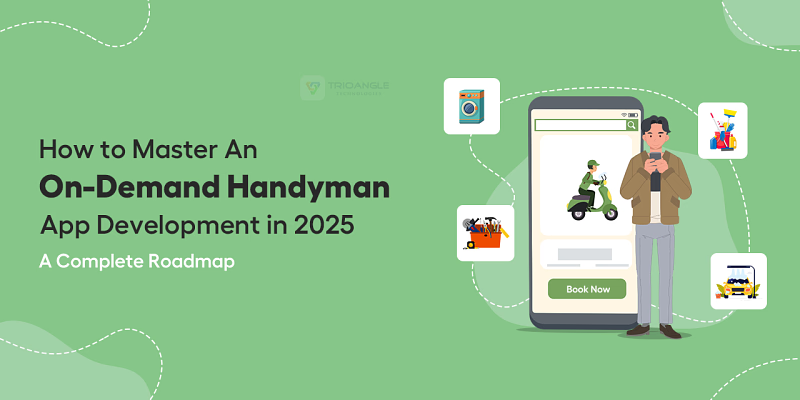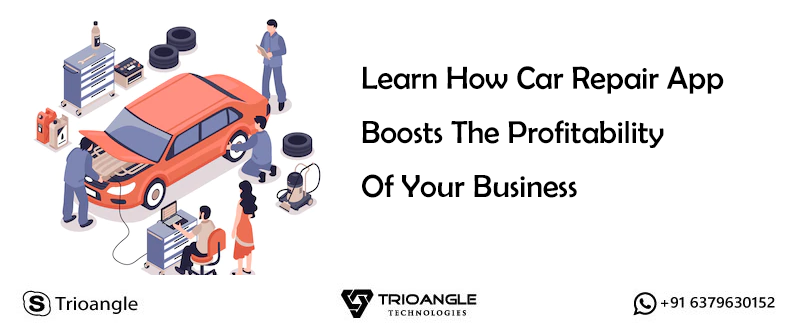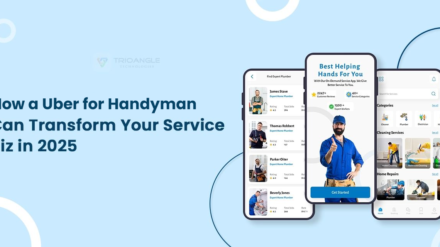On-demand services are revolutionizing daily convenience, especially handyman services. They let you access everything from expert home cleaning to beauty treatments right at your fingertips.
As we step into 2025, the trend is clearer that users crave seamless, instant solutions tailored to their busy lives.
Whether it’s a super clean car or speedy light installation, today’s top services are just a tap away, making life easier, faster, and smarter than ever before.
So, are you excited to create your own on-demand app in 2025? This blog breaks down everything you need to know to build a smart, user-friendly on-demand service app from concept to launch!
Why are On-Demand Apps for Handyman Services so Popular?
- Convenience and Time-Saving – On-demand apps provide users instant access to services and products with just a few taps, saving time and enhancing convenience.
- Widespread Smartphone and Internet Access – The global proliferation of smartphones and affordable mobile internet makes these apps accessible anytime, anywhere.
- Advanced Technology Integration – Technologies like AI enable personalized experiences, boosting user satisfaction and loyalty.
- Significant Market Growth – With the global market valued at over $134 billion in 2022 and growing rapidly, businesses benefit from increased reach and improved operational efficiency.
Market Statistics – Why Are On-Demand Apps Needed In 2025?
- By 2025, the total revenue of businesses in this sector is expected to reach $335 billion. Currently, half of the users regularly engage with on-demand apps that offer convenience.
- Moreover, over 60 percent of customers are ready to pay a premium for delivery services. This trend has significantly transformed the business landscape, elevating the industry to unprecedented levels.
How Does an On-Demand App Benefit Businesses
On-demand apps boost business by increasing customer engagement and retention through continuous, personalized interactions. They drive revenue growth by expanding market reach and enabling flexible monetization models.
Scalability and flexibility allow businesses to adapt and grow efficiently with changing demands. Additionally, these apps enhance customer satisfaction and convenience by providing seamless, real-time services anytime, anywhere.
Therefore, let’s dive into the top trending on-demand handyman services that are shaping the industry and offering exciting opportunities for growth in 2025.
Top Trending On-Demand Services in 2025
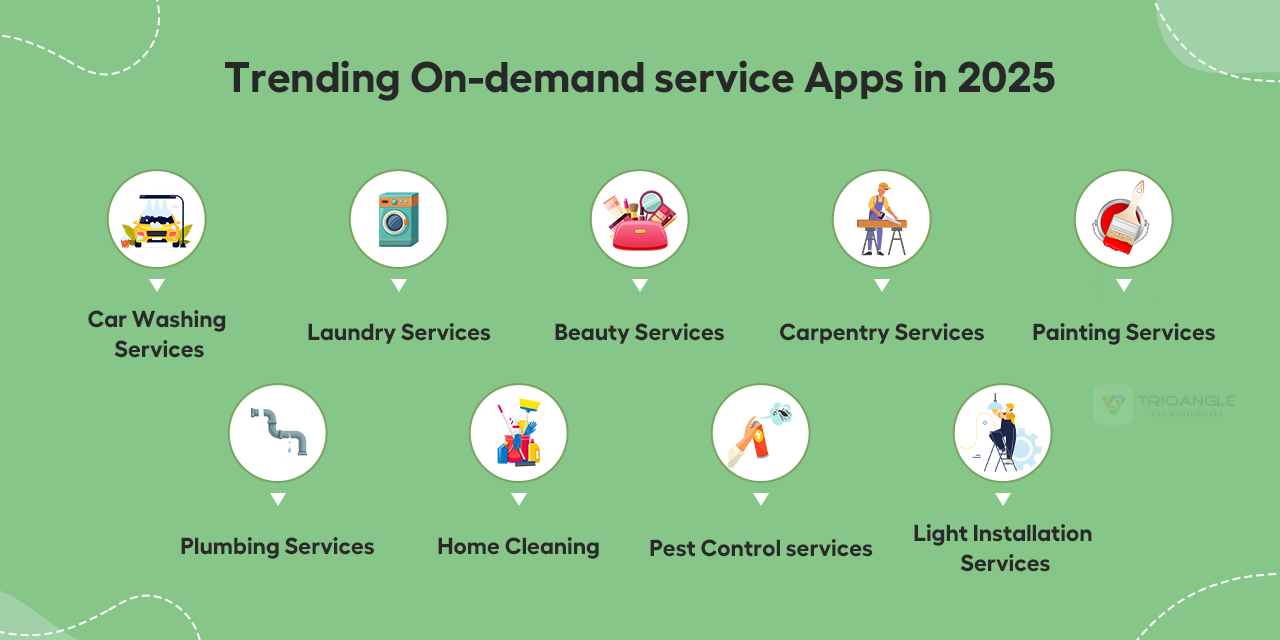
🚘 Car Washing Services
Keep your car looking sleek and preserve its value with professional car washing. Hence, expert cleaning, waxing, and polishing remove dirt and stains, helping your vehicle stay shiny and protected year-round.
🫧 Laundry Services
Laundry services have become a lifesaver for busy individuals aiming to keep their wardrobe fresh without the hassle.
These services handle everything from washing and drying to folding and ironing, ensuring your clothes receive the care they deserve.
💇 Beauty Services
Pamper yourself with professional beauty treatments, including haircuts, facials, and spa services, designed to enhance your look and boost your confidence for any occasion.
🪓 Carpentry Services
Transform your space with skilled carpentry like custom furniture, detailed woodwork, and repairs tailored for your home or office. Professional craftsmanship ensures durable, stylish results to suit the customer’s needs.
🎨 Painting Services
Professional painting refreshes any space with clean, smooth, and vibrant finishes.
Experts assist in selecting colors and finishes that complement interior or exterior surfaces, enhancing both the aesthetic appeal and durability of walls.
🧑🔧 Plumbing Services
Reliable plumbing ensures comfort and functionality by addressing leaks, unclogging drains, and installing pipes and sanitation systems.
Timely maintenance prevents water damage and costly repairs, promoting efficient water flow.
🧹 Home Cleaning
Maintaining cleanliness is effortless with professional home cleaning that includes dusting, vacuuming, mopping, and deep kitchen and bathroom cleansing.
Delegating these tasks to experts results in a sparkling, hygienic living environment that promotes well-being.
🚫 Pest Control services
Effective pest control protects homes and workplaces from insects, rodents, and other pests that threaten health and comfort.
Trained professionals assess infestations and apply safe, targeted treatments to eliminate pests and prevent future recurrence, maintaining a secure and healthy environment.
💡Light Installation Services
Professional light installation enhances spaces with safe and energy-efficient lighting solutions. From new fixture setups to LED upgrades and outdoor security lighting, precise and compliant installations improve ambiance and safety for any property.
These are some of the top trending handyman services in 2025. Now, let’s dive into the effective features that will enhance the performance of the on-demand service app.
Effective Features to Incorporate in An On-Demand App
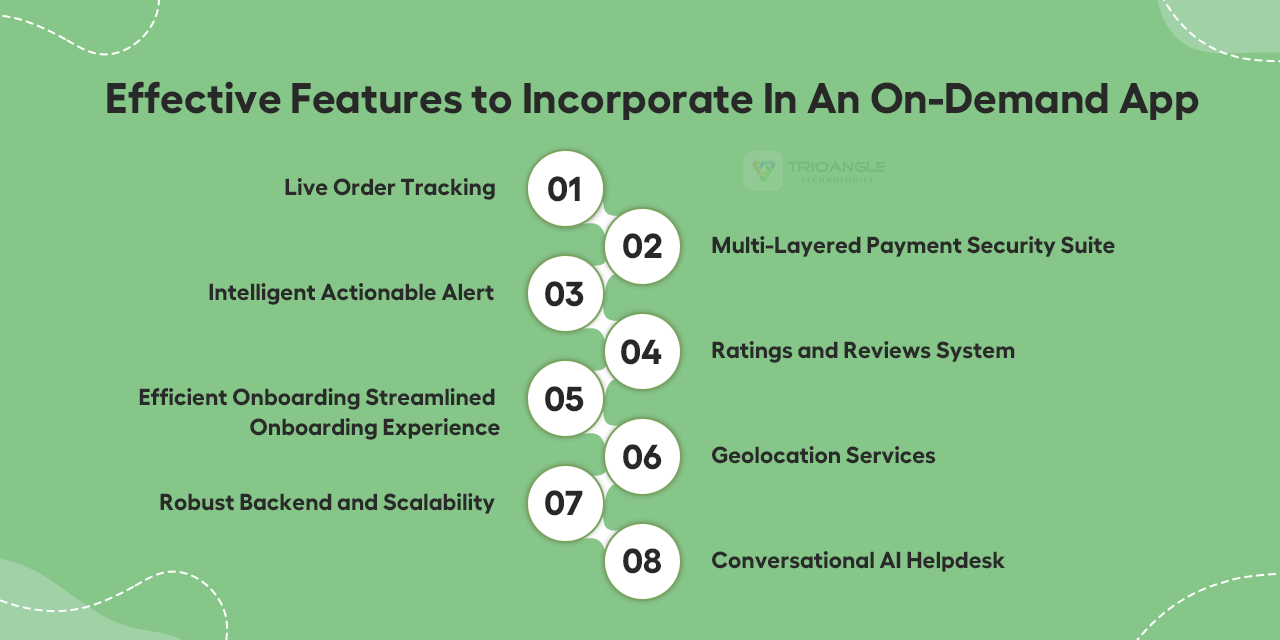
Features needed to incorporate in an On-Demand App are listed below,
- Live Order Tracking – Live order tracking enables users to monitor the status and location of their orders or services live, building transparency and trust throughout the process.
- Multi-Layered Payment Security Suite- This option enables multiple payment options with robust security measures to protect user data and encourage seamless transactions.
- Intelligent Actionable Alert – This functionality keeps the users informed with timely updates about their orders, promotions, and important alerts, enhancing engagement and app usage.
- Ratings and Reviews System – The Ratings and reviews system permits users to provide feedback on services. This feature increases trust among users and helps improve service quality.
- Efficient Onboarding Experience – Simplifies the registration and sign-in process through social media logins or guest modes. This reduces user drop-off and encouraging app adoption.
- Geolocation Services – Utilizes GPS technology to match users with nearby providers, optimize delivery routes, and facilitate precise location tracking for faster service fulfillment.
- Robust Backend and Scalability – Ensures the app performs smoothly during peak loads and increases traffic, maintaining reliability and responsiveness.
- Conversational AI Helpdesk – Integration of AI offers in-app support features like chatbots, live chat, or FAQs to promptly address user issues and enhance satisfaction.
Next, we’ll explore how to get started with on-demand app development, covering key steps from business model definition to launching your app.
How to Get Started With On-Demand App Development
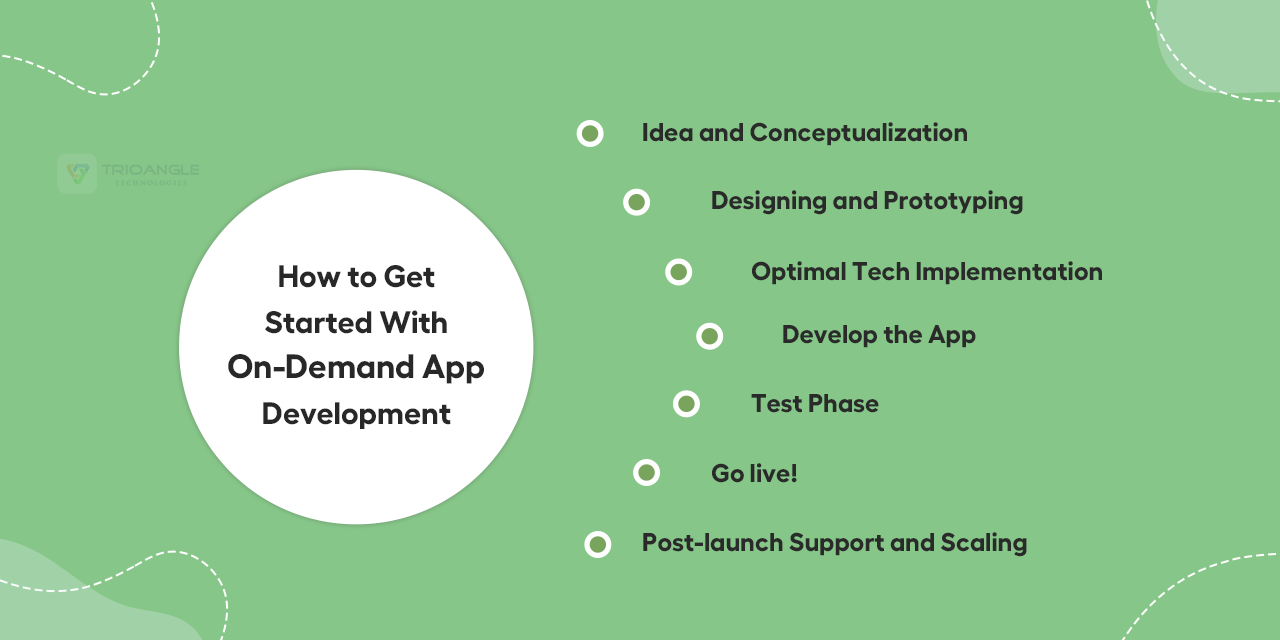
Steps to build an on-demand app development are described as follows,
Idea and Conceptualization
Every great on-demand app begins as a spark, an idea that targets a real-world problem.
At this step, think about who will use your app, what unique twist you offer, and how you’ll stand out from competitors. Putting together a focused business plan gives your vision shape and direction.
Designing and Prototyping
Once the concept is set, designing and prototyping bring an app’s user experience to life with rapid, clickable models that validate ideas and refine interfaces early. Early testing uncovers insights, enabling smooth modifications without expensive coding.
Balanced design for both customer and provider sides, combined with developer input and smart use of templates, ensures a seamless, cost-effective launch that truly resonates.
Optimal Tech Implementation
Choosing the appropriate technology stack and software architecture is critical to supporting your app’s performance, scaling, and feature requirements.
This includes selecting suitable programming languages, frameworks, and backend infrastructure that can handle real-time functionality and high user load typical for on-demand apps.
Cloud services and APIs are also considered to ensure reliability and speed. The technology choice should also be aligned with the planned development timeline, budget, and future scalability to accommodate growth and feature expansion.
Develop the App
The development phase translates the required designs and functional requirements into working software. This involves building frontend interfaces and backend systems where business logic, data processing, and integrations reside.
Development requires coordination among mobile app developers, backend engineers, and possibly web developers. Reusability of code, adoption of SDKs, and even machine learning integrations can optimize performance and scalability.
Also, development is an iterative process where continuous feedback loops from prototyping and early testing guide refinement.
Test Phase
Testing is a crucial phase, ensuring the app’s functionality, usability, and reliability meet expectations before launch. It includes a combination of automated and manual testing to detect bugs, performance bottlenecks, and security vulnerabilities.
Go live!
Launch the app on relevant platforms, often starting with a soft release. Monitor user feedback and analytics closely. Prepare marketing and backend systems to handle real traffic.
Post-launch Support and Scaling
After going live, continuous support is necessary to maintain app performance, fix bugs, and update features based on user feedback.
Regular updates ensure compatibility with new mobile OS versions and evolving user expectations. Strategic scaling also includes optimizing monetization strategies and possibly integrating advanced technologies for smarter operations.
Now that we have seen how the apps are built, let’s take a look at the cost of creating an on-demand service app.
How Much Does It Cost to Create an On-Demand Service App?
The cost of the app depends on the factors used to build the on-demand service apps. It involves factors like,
- App architecture and feature intelligence – A more complicated app will be more costly to develop. Features like real-time tracking, multi-language support, and AI integration will increase the cost compared to a basic app.
- System platform planning – The cost of building an on-demand service app depends on the platform chosen. Opting for one platform is cheaper, but choosing both single and cross-platform will reach a larger audience, albeit at a higher cost. Cross-platform frameworks like react native and Flutter can reduce costs, though they may not fully optimize each platform.
- Backend services and connectivity – Third-party services such as payment gateways, maps, messaging services, and social logins can be integrated using APIs. The number of integrations in an app will affect the complexity and cost of development.
- Data protection and privacy control – Security is important for any app, especially for on-demand service platforms that deal with sensitive information like payment details, addresses. Data encryption, secure payment gateways, and GDPR compliance take time to develop but are also essential for building user trust.
- Maintenance and update services – Continuous maintenance is required for the app to always be running. This includes updating iOS and Android, fixing bugs, and adding features based on user feedback. Therefore, these updates also add to this list.
Hence, considering all these factors, the on-demand service app for handyman services ranges from $1,000 to $300,000.
Closing Thoughts
In closing, it’s clear that 2025 is primed for explosive growth in on-demand app development for handyman services, as technology and user expectations soar side by side.
If you want to create a must-have on-demand app or improve your existing service, keep in mind that success requires a mix of bold ideas and technical skills. Focus on strong real-time features, secure payments, and smooth location tracking.
Also, prioritize user feedback and ensure your app can grow and adapt. By doing this, you’ll stand out in this fast-paced market.
The future of on-demand service apps isn’t just about convenience; it’s about creating smarter, more connected experiences that keep people coming back for more!

